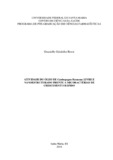| dc.creator | Rossi, Grazielle Guidolin | |
| dc.date.accessioned | 2021-05-12T17:15:09Z | |
| dc.date.available | 2021-05-12T17:15:09Z | |
| dc.date.issued | 2018-02-28 | |
| dc.identifier.uri | http://repositorio.ufsm.br/handle/1/20847 | |
| dc.description.abstract | Rapidly Growing Mycobacteria (RGM) are emerging pathogens responsible for various
human infections, although they are often considered only as contaminants or colonizers. The
formation of biofilms by these microorganisms causes great concern for public health, due to
its greater pathogenicity in humans and antimicrobial resistance. Microbial cells within the
biofilm are protected by an autoproduced polymer matrix that delays the diffusion of
antimicrobials, preventing the drug from penetrating the deeper layers and having its effective
action. Thus, it is important to seek effective alternatives against the formation of biofilms. In
this sense, the use of biological products as well as the use of nanostructures have been
studied for the control of formation and development of biofilms. This work had as main
objective to evaluate the action of the essential oil (EO) of Cymbopogon flexuosus free and in
nanoemulsion on strains of RGM, in planktonic and sessile forms. EO was chemically
characterized. The nanoemulsion obtained by the homogenization method under high stirring
was characterized for its stability, surface charge and particle size. The assays of Minimum
Inhibitory Concentration (MIC) and time-kill curve were determined against standard strains
of RGM Mycobacterium abscessus (ATCC 19977), Mycobacterium fortuitum (ATCC 6841)
and Mycobacterium massiliense (ATCC 48898). The ability of the oil and nanoemulsion to
inhibit biofilm formation and to destroy it was evaluated by semi-quantitative macro
technique. In the susceptibility test of the microorganisms in planktonic form, the
nanoemulsion presented higher microbial activity, with MIC values lower than those
presented by free EO. However, the free EO had bactericidal action, while the nanostructure
had only bacteriostatic action. In the activity evaluation against RGM biofilms, both were
efficient in the destruction of the biofilm already formed, while only the free oil inhibited the
formation of mycobacterial biofilm. The results of this dissertation impact on the discovery of
a new pharmacological formulation, capable of enhancing the effects of EO and impairing the
formation of biofilms. In addition, this work stimulates the research in methodologies that aim
to clarify the influence exerted by the EO and the nanoemulsion on the genetic and
physiological factors associated with the biofilms formation. | eng |
| dc.language | por | por |
| dc.publisher | Universidade Federal de Santa Maria | por |
| dc.rights | Attribution-NonCommercial-NoDerivatives 4.0 International | * |
| dc.rights.uri | http://creativecommons.org/licenses/by-nc-nd/4.0/ | * |
| dc.subject | MCR | por |
| dc.subject | Biofilmes | por |
| dc.subject | Capim-limão | por |
| dc.subject | Nanoemulsão | por |
| dc.subject | RGM | eng |
| dc.subject | Biofilms | eng |
| dc.subject | Lemongrass | eng |
| dc.subject | Nanoemulsion | eng |
| dc.title | Atividade do óleo de Cymbopogon flexuosus livre e nanoestruturado frente a micobactérias de crescimento rápido | por |
| dc.title.alternative | Oil activity of free and nanoestructured Cymbopogon flexuosus in front of rapidly growing mycobacteria | eng |
| dc.type | Dissertação | por |
| dc.description.resumo | As micobactérias de crescimento rápido (MCR) são patógenos emergentes responsáveis por
diversas infecções em humanos, embora muitas vezes sejam considerados apenas como
contaminantes ou colonizadores. A formação de biofilmes por esses micro-organismos causa
grande preocupação para a saúde pública, devido sua maior patogenicidade em humanos e a
resistência aos antimicrobianos. As células microbianas dentro do biofilme são protegidas por
uma matriz polimérica autoproduzida que retarda a difusão dos antimicrobianos, impedindo
que o fármaco penetre nas camadas mais profundas e tenha sua ação efetiva. Deste modo,
torna-se importante buscar alternativas eficazes contra a formação de biofilmes. Neste
sentido, o uso de produtos biológicos, bem como a utilização de nanoestruturas vêm sendo
estudados para o controle de formação e desenvolvimento de biofilmes. Este trabalho teve
como objetivo principal avaliar a ação do óleo essencial (OE) de Cymbopogon flexuosus livre
e em nanoemulsão sobre cepas de MCR, na forma planctônica e séssil. O OE foi caracterizado
quimicamente. A nanoemulsão obtida pelo método de homogeneização sob alta agitação foi
caracterizada quanto a sua estabilidade, carga de superfície e tamanho de partícula. Os ensaios
de Concentração Inibitória Mínima (CIM) e de curva de morte foram determinadas contra as
cepas padrão de MCR Mycobacterium abscessus (ATCC 19977), Mycobacterium fortuitum
(ATCC 6841) e Mycobacterium massiliense (ATCC 48898). A capacidade do óleo e da
nanoemulsão em inibir a formação do biofilme e destrui-lo foi avaliada por macrotécnica
semi-quantitativa. No ensaio de suscetibilidade dos micro-organismos na forma planctônica, a
nanoemulsão apresentou maior atividade microbiana, com valores da CIM inferiores aos
apresentados pelo OE livre. No entanto, o OE livre teve ação bactericida, enquanto a
nanoestrutura teve somente ação bacteriostática. Na avaliação da atividade contra biofilmes
de MCR, ambos foram eficientes na destruição do biofilme já formado, enquanto somente o
óleo livre inibiu da formação de biofilme micobacteriano. Os resultados desta dissertação
impactam sobre a descoberta de uma nova formulação famacêutica, capaz de potencializar os
efeitos do OE e prejudicar a formação de biofilmes. Ademais, este trabalho estimula o
aprofundamento em metodologias que visam esclarecer a influência exercida pelo OE e a
nanoemulsão sobre os fatores genéticos e fisiológicos associados à formação de biofilmes. | por |
| dc.contributor.advisor1 | Campos, Marli Matiko Anraku de | |
| dc.contributor.advisor1Lattes | http://lattes.cnpq.br/6421182991125434 | por |
| dc.contributor.advisor-co1 | Santos, Roberto Christ Vianna | |
| dc.contributor.referee1 | Peres, Paulo Edelvar Correa | |
| dc.contributor.referee2 | Machado, Alencar Kolinski | |
| dc.publisher.country | Brasil | por |
| dc.publisher.department | Análises Clínicas e Toxicológicas | por |
| dc.publisher.initials | UFSM | por |
| dc.publisher.program | Programa de Pós-Graduação em Ciências Farmacêuticas | por |
| dc.subject.cnpq | CNPQ::CIENCIAS DA SAUDE::FARMACIA | por |
| dc.publisher.unidade | Centro de Ciências da Saúde | por |



